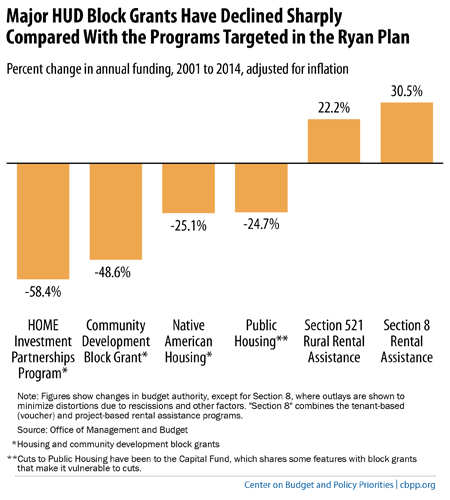BEYOND THE NUMBERS
Why the Ryan Plan Should Worry Those Who Are Concerned About the Affordable Housing Crisis, Part 1
A centerpiece of House Budget Committee Chairman Paul Ryan’s poverty plan is the proposal to consolidate 11 safety net programs — including four housing assistance programs — into a single, flexible block grant to states. Among its downsides, this proposal threatens to lead to reductions in funding that provides housing assistance to millions of low-income families and individuals.
My colleagues have already set out some of the reasons to be concerned by Chairman Ryan’s proposal:
- Block grants have proven to be easy targets for funding cuts, in part because their inherent flexibility makes it difficult to demonstrate how cuts would affect needy families and communities.
- Total funding to assist low-income families — from federal, state, and local sources combined — likely would also decline, because broad block grants afford states opportunities to use block grant funds to replace state and local funds now going for similar services.
- Ryan’s proposal would make it more likely that some families would receive additional services only if other needy individuals and families receive significantly less assistance.
Because housing assistance and SNAP make up more than 80 percent of Ryan’s Opportunity Grant, any cuts in block grant funding would very likely reduce families’ access to these programs, as my colleague LaDonna Pavetti has explained.
The history of housing and community development program funding shows the risk of funding cuts that rental assistance programs face under Ryan’s plan. Funding for flexible block grant programs such as the Community Development Block Grant (CDBG), HOME (which helps states and localities develop and preserve affordable homes for owners and renters), and the Native American Housing Block Grant has fallen sharply over time. Meanwhile, programs that provide more narrowly prescribed forms of assistance to low-income families and that Congress funds separately each year — a category that includes housing vouchers, rural rental assistance, Section 8 Project-Based Rental Assistance, and Public Housing, the four rental assistance programs that Ryan’s proposal targets — have generally avoided reductions (sequestration in 2013 notwithstanding). (See chart.)

The reasons are easy to understand. For example, HUD provides Congress every year with precise estimates of the cost of renewing the Housing Choice Vouchers that assist more than 2 million low-income families. If Congress fails to provide sufficient funding to renew the vouchers, some of those families will lose assistance (and possibly their homes). In contrast, policymakers can justify cutting a block grant by claiming that local agencies can avoid cutting direct assistance to families by using their flexibility to shift funds from other activities.
Cuts in rental assistance would fall mainly on low-income people who are elderly or have disabilities and working-poor families with children. More than 80 percent of households with rental assistance in 2010 were elderly, had a disability, worked, or had recently worked. (2010 is the most recent year for which these data are available to us.)
Rising rents and stagnant incomes have left increasingly more low-income Americans unable to afford decent, stable housing without cutting back on other basic needs. Already fewer than one in four eligible low-income families receive rental assistance due to funding limitations, and waiting lists are long. The cuts that would likely result from the Ryan plan would make this shortfall more severe and thus leave more families struggling to pay the rent and keep their homes.
